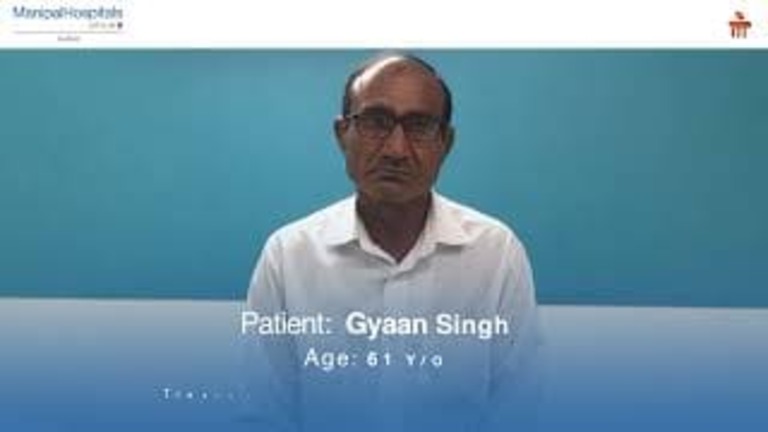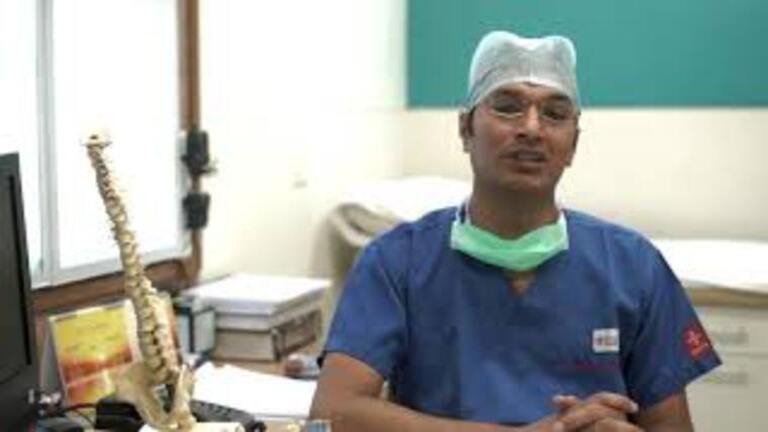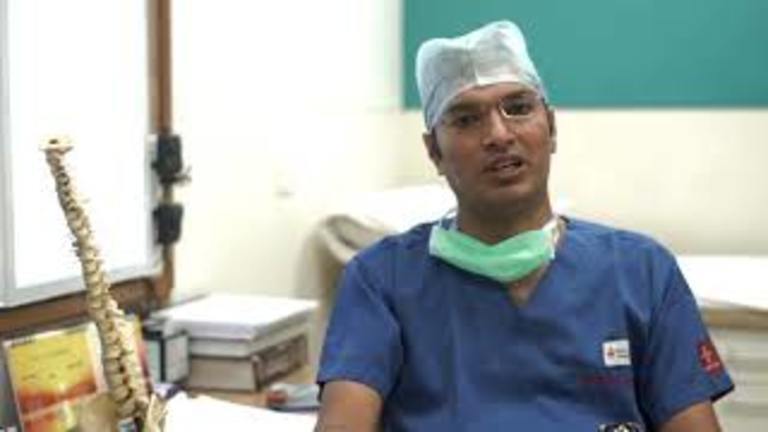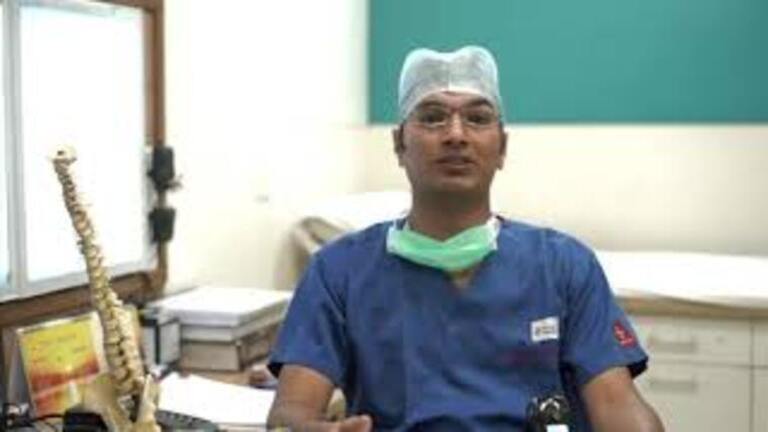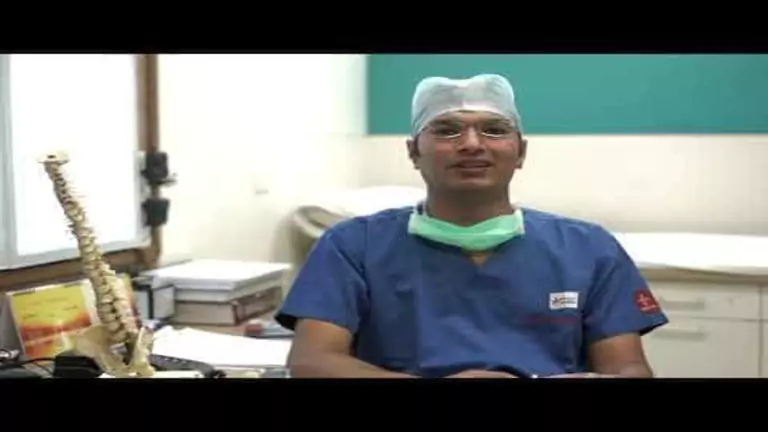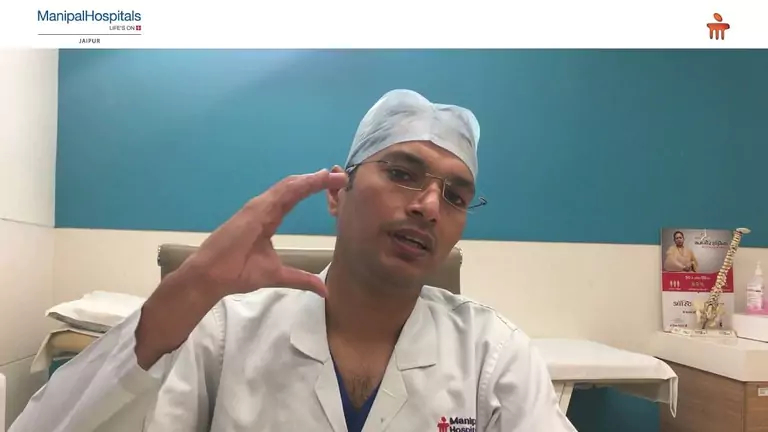

Spine Care
Best Spine Hospital in Jaipur
Why is it that, despite having the same amount of pain, one person can be diagnosed with a mild backache while another is diagnosed with a significant spine condition? It's because every spine injury is different and can manifest in different ways. Consult our Best Spine Hospital in Jaipur if you need treatment and care for spine issues. The spinal cord is housed inside the vertebral column. Together, they make the spine, also called the back, in simple terms. It is one of the body's most vital organs as it houses the spinal cord, is responsible for most involuntary reactions and helps connect the brain with the rest of the body through the dense network of nerves inside it. The spine is the part of the body that connects the neck and lower back and includes bones called vertebrae. Discs are cushions between the vertebrae and separate them. Spine surgery treats conditions that affect the spine. Doctors recommend spine surgery when one of these discs has ruptured or become damaged. This surgery aims to remove any damaged disc tissue and replace it with a healthy disc to relieve pain caused by pressure on nerves in the spine. Many different conditions can cause damage to the spine, including osteoarthritis, rheumatoid arthritis, degenerative disk disease, spinal stenosis, scoliosis and spondylolisthesis.

OUR STORY
Know About Us
Why Manipal?
Manipal Hospitals is the best spine hospital in Jaipur. We offer diagnosis and treatment of the entire range of spine disorders, including arthroscopic surgery and minimally invasive procedures, pain-reducing and recovery-accelerating procedures for a range of orthopaedic and neurological conditions that affect the spine and spinal cord. Our expert team includes neurosurgeons, neurologists, orthopaedic surgeons and other specialists.
Our facilities include minimally invasive surgeries and pain-reducing and recovery-accelerating procedures for various orthopaedic and neurological conditions affecting the spine and spinal cord.
At Manipal Hospitals, we are known for accurate diagnosis and appropriate treatment, which has made us the most trusted Spine Care Hospital in Jaipur.
Treatment & Procedures
A spinal osteotomy is a surgical procedure used to correct certain deformities of the adult or pediatric spine. These include the posterior column osteotomy (PCO), the pedicle subtraction osteotomy (PSO) and vertebral column resection (VCR).
Spinal stenosis is a narrowing of the spaces within your spine, which can put pressure on the nerves that travel through the spine.
As the name suggests, Spine Stabilization surgery can now be performed using minimally invasive stabilization procedures that offer patients a safe and effective alternative to back fusion with a faster recovery. It is done through a tiny incision without cutting or damaging the surrounding muscles.
The goals of minimally invasive transforaminal lumbar interbody fusion (TLIF) and posterior lumbar interbody fusion (PLIF) are to address the cause of your back pain and to keep your spine stable by fusing two or more of your vertebrae together.
Cervical laminoplasty is a surgical technique that removes pressure from the spinal cord in the neck. Pressure on the spinal cord can be due to various causes including degenerative changes, arthritis, bone spurs, disc herniations, tumors, or fractures.
Spinal conditions such as scoliosis (curving of the spine), kyphosis (increasing roundback of the spine), spondylolysis (stress fracture of the spine), and spondylolisthesis (movement of one part of the spine on another part) may affect children during their early or late childhood years.
A vertebral column resection is a procedure reserved for the most severe spinal deformities and involves removing segments of the spine including the body of the vertebra and the posterior elements, which include the lamina, transverse process, and ribs.
Anterior lumbar interbody fusion (ALIF) is a spine surgery that involves approaching the spine from the front of the body to remove disc or bone material from in between two adjacent lumbar vertebrae. The procedure may be performed either as an open surgery or using minimally invasive techniques.
A spinal tumor is an abnormal mass of tissue within or surrounding the spinal cord and/or spinal column. These cells grow and multiply uncontrollably, seemingly unchecked by the mechanisms that control normal cells. Spinal tumors can be benign (non-cancerous) or malignant (cancerous). Primary tumors originate in the spine or spinal cord, and metastatic…
Spinal reconstruction surgery may be necessary for patients who have a deformity or misalignment that affects a major portion of the spine.
Vertebroplasty and kyphoplasty are procedures used to treat painful vertebral compression fractures in the spinal column, which are a common result of osteoporosis. Our neurosurgeons use imaging guidance to inject a cement mixture into the fractured bone (vertebroplasty) or insert a balloon into the fractured bone to create a space and then fill it…
Posterolateral lumbar fusion is spine surgery that involves placing bone graft between elements in the back, or posterior, of the spine, leaving the disc space intact. The procedure may be performed using minimally invasive surgical techniques.
A discectomy is a cutting-edge, minimally invasive procedure proven to reduce pain caused by disc herniations (sciatica). Also called microlumbar discectomy (MLD), this is an advanced procedure where the herniated or protruding portion of an intervertebral disc that is compressing the spinal cord and affecting the nerve root is removed, shrinking an…
Dynamic lumbar spine stabilization is a surgical technique that stabilizes the spine with flexible materials to allow for more mobility in the spine than traditional spinal fusion surgery.
This refers to removing one or more discs to treat herniated discs and degenerative disc disease or it is also used in combination with various spinal fusion procedures.
The disc is the soft cushioning structure located between the individual bones of the spine, called vertebra. It is made of cartilage-like tissue. In most cases, the disc is flexible enough to allow the spine to bend. An artificial disc (also called a disc replacement, disc prosthesis or spine arthroplasty device) is a device that is implanted into…
This is a minimally invasive procedure and is done to treat compression fractures caused by osteoporosis.
This procedure is performed to release pressure from the spinal cord, that is mainly caused by spinal stenosis.
This minimally invasive procedure removes a small part of disc material and portion of bone to relieve the compression of nerve roots
This procedure corrects misalignments of pinched nerves or the spinal column. Posterior lumbar interbody fusion and anterior lumbar interbody fusion are the two types of spinal fusion procedures performed.

What are Common Spine Conditions?
Spinal conditions are a significant cause of disability. The most common disorders of the spine are Tumours, Spinal Stenosis, Herniated Discs, Abscesses, Hematomas, Vertebral fractures, and Degenerative disc disease.
- Herniated discs occur with a break in the fibrous outer covering of an intervertebral disc, and its contents press against the spinal cord or nerve root. It causes pain, weakness or numbness in the back or legs.
- Tumours can develop anywhere in the spine and can be benign or malignant (cancerous). If a tumour presses on nerves or causes compression damage, it may cause pain, numbness or weakness in an arm or leg.
- Spinal stenosis is the space narrowing inside the spinal column, which can result from arthritis, bone spurs on vertebrae or other changes in bones that make it difficult for nerves to pass through from one segment to another freely without being pinched by surrounding tissues such as bone spurs around joints (osteoarthritis).
- An Abscess is a pus pocket that forms around a bone when there is an infection or other foreign body in the bone. The bone cannot heal itself, so it becomes infected and fills with fluid, forming into pus. The abscess can lead to compression of surrounding structures, such as nerves and blood vessels, causing pain and risk of possible paralysis.
- Hematomas are caused by bleeding within the spinal canal. They can occur after trauma to the spine.
- Vertebral fractures can occur from osteoporosis (density loss of bones), osteogenesis imperfecta (thin bones), metastatic cancer (cancer spreading from another part of the body), osteomyelitis (infection in bone/joint), or osteoporosis-related compression fractures due to weight loss or lack of exercise. These fractures cause radiating pain.
- Degenerative disc disease, or "slipped disc" or "herniated disc", happens when an intervertebral disc's soft, gel-like centre pushes out through a weak spot in the surrounding bone. The disc bulges out, compressing the spinal cord or nerve roots and causing pain, numbness and tingling in one or both legs.
Diagnostic Facilities
Imaging
Imaging looks at the human body's structure and function using various medical imaging technologies.
Imaging diagnoses spinal conditions, including degenerative disc disease, spinal stenosis, spondylolisthesis and scoliosis. Imaging can also determine whether any abnormalities in the spinal canal could cause pain or impede nerve function.
The most common imaging techniques include X-Rays, MRI and CT Scans.
Myelography
Myelography diagnoses spinal conditions by injecting a contrast dye into the spine through a catheter. The dye helps radiologists visualise the spinal cord and any surrounding tissues.
Electromyogram
An electromyogram measures the electrical activity of muscles. This test diagnoses spinal conditions, including nerve damage and muscle weakness. By analysing these impulses, doctors can determine whether the nerve pathways are functioning correctly, indicative of nerve damage or muscular weakness.
Treatments
Cervical Laminoplasty
Cervical laminoplasty removes pressure from the spinal cord in the neck. The patient typically has stenosis, or spinal canal narrowing, which causes spinal cord compression. The surgeon removes bone spurs and other obstructions compressing the spinal cord.
Cervical laminoplasty can be an open incision or endoscopically, using a tiny camera attached to a tube inserted into the body.
Artificial Disc Replacement
Artificial disc replacement helps remove the damaged disc, insert an artificial disc made of metal, ceramic, or plastic, and provides a cushion between vertebrae to help relieve nerve pressure in the back.
A small incision in the back near the damaged disc inserts a prosthetic device. The prosthetic device will act as a cushion between vertebrae to help relieve pressure on nerves in the back.
Surgery for Spinal Tumours
Surgery for Spinal Tumours is complex disorders that affect the spine. Most spinal tumours are benign (non-cancerous), but some can be malignant (cancerous).
Surgery for spinal tumours aims to remove as much of the tumour as possible while minimising damage to surrounding tissue and structures. The procedure often involves entering through an incision in the back but may require other approaches depending on where exactly in the spine the tumour has grown.
Spinal Osteotomies
Spinal Osteotomies correct deformities of the spine. They can be done either as an alternative or in conjunction with spinal fusion. This procedure is done by cutting bones out of the vertebrae and realigning them to fit together better. It treats conditions like Scoliosis, Kyphosis, and other spine abnormalities.
Anterior Interbody Fusion
Anterior interbody fusion stabilises the spine by fusing the bones in the front of the vertebrae. It treats degenerative disc disease, spinal instability, or spinal stenosis. This procedure aims to fuse the bones in the front of the vertebrae to support each other.
Spinal Column Reconstruction
Spinal column reconstruction repairs the vertebral column after a traumatic injury. It can treat vertebral fractures, spinal deformities, and spinal instability.
The procedure involves removing the damaged disc material to replace it with an artificial disc replacement device or graft material such as bone chips or cartilage.
Discectomy
Discectomy removes a herniated disc from the spine. A herniated disc is when an intervertebral disc's soft, gel-like centre pushes through its outer covering and presses on a nerve root, causing pain and weakness. Discectomy relieves spinal cord and nerve root pressure because of a herniated disc.
The procedure involves creating an opening in the vertebrae so the surgeon can remove the injured disc fragment and relieve pressure on damaged nerves.
Postero Lumbar Fusion
Postero Lumbar fusion uses bone grafts and metal rods to fuse vertebrae. The goal is to relieve pain, restore strength and stability to the spine, and prevent further spinal degeneration. It can also treat spinal stenosis (narrowing of the spinal canal) or spondylolisthesis (slippage of one vertebra on top of another).
A small incision in the back near the spine removes some bone from each vertebra.
Vertebral Body Resection
Vertebral body resection involves removing part of the vertebrae to treat compression fractures and spinal stenosis.
Vertebral body resection involves removing part of the vertebrae to relieve pressure on nerve roots, relieve spinal cord compression or decompress the spine. The procedure happens through an open surgery or endoscopic approach.
Minimally Internal Decompression For Spinal Stenosis
Spinal stenosis is when the spinal canal narrows and causes pressure on the spinal cord and nerves.
Minimally internal decompression treats spinal stenosis using small openings in the vertebrae and removing bone spurs that cause compression on the spinal cord or nerves.
Vertebroplasty
Vertebroplasty treats osteoporosis and spinal fractures. During the procedure, bone cement is injected into the spine's vertebrae to help stabilise it, making it stronger and more likely to heal properly after an injury.
Vertebroplasty happens in the front of the vertebrae (anterior) when there is a fracture in a single vertebra or their sides (posterior) when there are multiple fractures or when one side of the spine has collapsed.
Kyphoplasty
Kyphoplasty treats vertebral compression fractures by injecting cement into the vertebrae to stabilise them and then removing the excess cement from the body with the aid of a balloon. It helps patients who are at risk for further fractures and need to be able to resume their daily lives as soon as possible.
Posterior and Transforaminal Lumbar Interbody Fusion (TLIF)
Posterior and Transforaminal Lumbar Interbody Fusion (TLIF) fuses the lumbar spine by placing an implant between the vertebrae. It treats spinal stenosis, the narrowing of the spinal canal, which puts pressure on the spinal nerves.
The procedure happens with or without the use of an artificial disc replacement. This procedure treats degenerative disc disease and spinal stenosis.
Spinal stabilisation
Spinal stabilisation treats severe back pain. The procedure involves using a brace worn around the ribs and pelvis to reduce the stress on the spine. Spinal stabilisation aims to stop or prevent further damage to the spine by keeping it still while it heals.
The procedure involves inserting screws or rods into the patient's vertebrae or creating an external brace that holds the vertebrae together.
Paediatric Spinal Surgeries
Paediatric Spinal Surgery corrects congenital disabilities and spinal injuries, including Scoliosis, Spina Bifida, and other conditions.
The procedure usually involves an incision in the skin above the injury or defect site to remove bone growths and other tissue causing harm to the child's spine.
Microdiscectomy Endoscopic Discectomy
Discectomy removes the herniated portion of the disc from the spinal canal. It treats chronic back pain caused by a herniated disc, which can be caused by lifting heavy objects or bending improperly.
The procedure can be done in two ways: Microdiscectomy and EndoscopicDdiscectomy. Both are minimally invasive, but microdiscectomy requires larger incisions and more extensive recovery time than endoscopic discectomy.
Laminectomy
A laminectomy removes part of the lamina, the bone that is the roof of the spinal canal. During the procedure, the surgeon removes any bone or tissue, compressing the nerve root and causing pain.
The decompression procedure can happen through an open incision or a minimally invasive technique.
Laminoplasty
Laminoplasty treats severe spinal curvature. It involves removing the lamina (the top of the vertebral arch) and any associated disc material or parts of the vertebrae to straighten the spine.
The surgeon removes any bone spurs pressing against the spinal canal nerves and then inserts a wedge of artificial material into the space between the vertebrae to stabilise and relieve pressure on the nerves.
Microdiscectomy
Microdiscectomy corrects spinal stenosis or a narrowing of the spinal canal. It also removes herniated discs, bulges in the spinal cord's outer covering that occur when the disc loses its water content and becomes dehydrated.
An incision in the lower back allows access to the spine, and then a long instrument removes part of the vertebrae and exposes the nerves damaged by disease or injury.
Spinal Fusion
Spinal fusion treats spinal deformities, such as Scoliosis and Kyphosis. It involves joining two vertebrae with bone grafts or synthetic material to correct the spinal curve.
Surgeons make an incision in the back, and then a small cut is made in the front between the ribs to access the spine. A bone graft is inserted between two vertebrae and then secured with screws, plates, or rods.
Book an appointment at the spine hospital Jaipur to get the finest treatment with the help of the team of spine surgeons in Jaipur.

Facilities & Services
Conditions treated at Manipal Hospitals' Spine care, but not limited to, are 1. Non-operative treatment of neck and back pain 2. Spinal injections of all types including RFA 3. Microdiscectomy and spinal decompressions 4. Endoscopic surgeries 5. Minimally invasive surgeries – PLIF, TLIF, OLIF 6. Artificial disc replacements 7. 24X7 Treatment of Spinal fractures and trauma 8. Vertebroplasty and Kyphoplasty Procedures for Osteoporotic fractures 9. Stem cell therapy for spinal cord injury 10. Scoliosis and Kyphosis treatment – Bracing to major corrective surgeries 11. Treatment of congenital defects and deformities of the spine 12. Management of Spinal infections 13. Treatment of Spinal and spinal cord tumours.
Facilities available at Manipal Hospitals, Jaipur
Manipal Hospitals is the spine care hospital in Jaipur. We offer accurate diagnosis and treatment. Our facilities include:
-
Non-Operative Neck and Back Pain Treatment
-
Spinal Injections
-
Radio-frequency Ablation
-
Microdiscectomy
-
Spinal Decompressions
-
Endoscopic Surgeries
-
Minimal Invasive Surgeries
-
Posterior Lumbar Interbody Fusion (PLIF)
-
Transforaminal Lumbar Interbody Fusion (TLIF)
-
Oblique Lateral Interbody Fusion (OLIF)
-
Artificial Disc Replacements
-
24X7 Spinal Fractures and Trauma Treatment
-
Osteoporotic Fracture Procedures
-
Vertebroplasty
-
Kyphoplasty
-
Stem Cell Therapy
-
Scoliosis and Kyphosis Treatment
-
Bracing for Major Corrective Surgeries
-
Treatment of Congenital Disabilities and Deformities of the Spine
-
Management of Spinal Infections
-
Treatment of Spinal and Spinal Cord Tumours
FAQ's
You may be in the hospital for 1 to 3 days; longer if you have spinal fusion. Rest is important. But doctors want you out of bed as soon as possible. Most people start physical therapy within 24 hours. Walk in to the spine care hospital in Jaipur to know more about it.
Slipped discs are caused by the discs in the spine becoming dehydrated, which causes them to slip out of place. It happens when the discs do not get enough water and nutrients from the blood vessels that feed them.
The most common cause of slipped discs is obesity and lack of exercise. Obesity can lead to excess pressure on the spine, and obese people are more likely to experience back pain. Other causes include poor posture, lifting heavy objects incorrectly and sitting at a desk job for long periods.
Consult the finest spine care hospital in Jaipur for recommendations to maintain good spine health.
The best exercises for maintaining a good spine are those that strengthen the core muscles, which are the muscles that help to stand up straight. These include the gluteal and abdominal muscles located around the hips and waistline.
Get the best recommendations from the best spine hospital in Jaipur. Consult us now.
Stem cell therapy uses stem cells to treat spine disorders. Stem cells, found in the human body and potentially developing into any cell type, are injected into an injured area to help heal the damaged tissue. After cancer treatments, stem cells regenerate damaged tissues and organs, such as bone marrow.
Stem cell therapy treats various conditions, including spinal cord injuries, degenerative disc disease, and osteoarthritis.
Meet the best spine surgeon in Jaipur to explore stem cell therapy to treat spine conditions.
Spine decompression relieves pressure on the spinal cord. It is performed by removing bone from the spine and treating various conditions.
Spine decompression happens when pressure on the spinal cord causes numbness or weakness in one or more limbs.
Visit Manipal Hospitals for spine decompression, spine surgery & treatment in Jaipur.
Conditions affecting the spine are complex, Manipal Hospitals help manage your pain and restore function. Our experts are the leaders in spine surgery, interventional spine therapies, and spine wellness. Together they ensure patient's recovery and improved quality of life with the least invasive, most appropriate, and most advanced treatment available. Contact us to know more about Spine care and book an appointment with one of our Spine care specialists today.


















